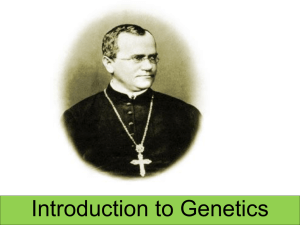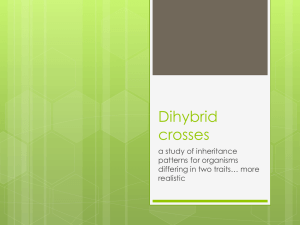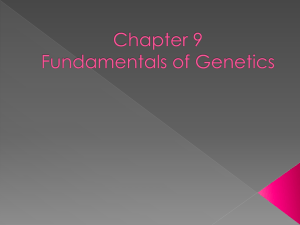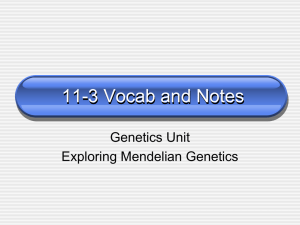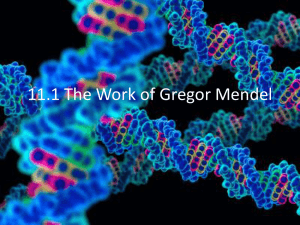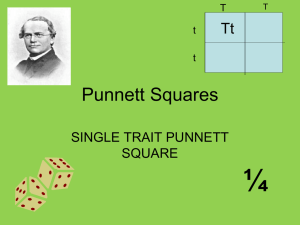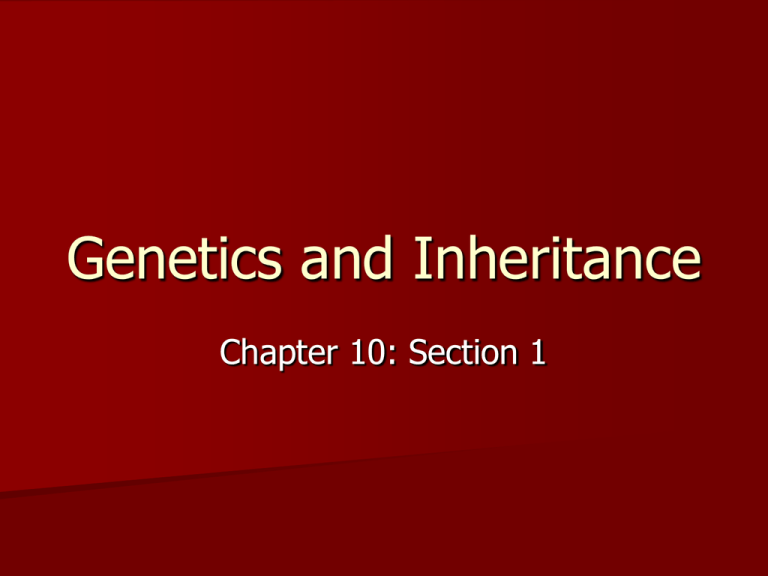
Genetics and Inheritance
Chapter 10: Section 1
Puppy-Dog Creations…
Choose
BLUE or YELLOW paper
FEMALE or MALE
SQUARE eyes or ROUND eyes
OVAL nose or TRIANGULAR nose
POINTED teeth or SQUARE teeth
***The rest is up to you!***
Note to Students:
In this section vocabulary is extremely
important. It leads the way to the rest of
your understanding.
As always, ask questions if you do not
understand!
VOCABULARY
TRAITS- a genetic (inherited)
characteristic
HEREDITY- The passing of traits from
parent to offspring
GENETICS- the branch of biology that
studies heredity (inherited traits)
Gregor Mendel
Who? Monk (priest)
What? Curious gardener trained in math
and science
When? 1851 is when it all began…
Where? Austria (central Europe)
Curiosity Leads the Way
He was curious as to why plants, specifically garden pea
plants, had different physical characteristics (short/tall, yellow
seeds/green seeds, purple/white flowers, etc.)
Observed that TRAITS were often similar to those of
their parents
Spent over 10 years experimenting with the thousands
of pea plants to understand HEREDITY
He was the first person to succeed in predicting how
traits are transferred from one generation to the next.
His work formed the foundation of GENETICS
Why Pea Plants?
Easy to grow
Grow quickly
Produce large number of offspring in one
generation (lots of data available at one time)
They have many traits that exist in only two
forms (makes it easier to study them)
Pea plants have both male and female parts on
the same flower; so fertilization can be
controlled.
Plant Vocabulary
Gametes- male and female sex cells
Fertilization- male gamete unites with the
female gamete
Zygote- the fertilized cell that develops into a
seed.
Pollination- transfer of pollen grains from male
reproductive organ to female reproductive
organ.
Pistil-female sex cells
Stamen-male sex cells
(pollen)
NOTE- in nature these
plants would be selfpollinating
Mendel developed a way
to cross-pollinate pea
plants
– Remove pollen from a
flower on one plant
and brush it on a
flower of a second
plant
– To prevent selfpollination he carefully
removed the stamens
from the flowers on
the second plants
FIGURE 10.1
Vocabulary Continued
Self-pollinating- The pollen of one flower
lands on the pistil of the same flower
Cross-Pollinating- The pollen of one flower is
placed on the pistil of a different flower.
**To prevent self-pollination Mendel removed the
stamen from the flowers on the second flower.**
Pure bred- always produces offspring with the
same form of a trait as the parent….its pure!
Let the Experiment Begin!
Mendel crossed PUREBRED plants with
opposite forms of the same trait. For
example he crossed a purebred tall plant
with a purebred short plant.
– Why purebreds??? Because those were the
plants that he knew what to expect from the
offspring.
Mendel carefully controlled his experiments
making sure that he studied only one trait
at a time to control the variables.
Experiment #1
Characteristic: Tall Plant vs Short Plant
NOTE: The parent plants were called the parent
generation or P generation and the offspring from this
cross were called the F1 generation.
Results: ALL F1 generation plants were
tall! The short trait had “disappeared”.
Experiment #2
He then allowed all of the F1 generation
to self-pollinate.
This generation was called the F2
generation.
Results: He discovered that about ¾ of
them were tall and ¼ were short. Short
trait had returned!
Experiment #3-???
He tested all of the
other main traits
– Flower color, Seed
shape, seed color,
seed coat color, pod
shape, pod color, and
flower position.
Results: All of the
traits had the same
results as plant
height!
Hybrids- offspring of parents that have
different forms of a trait.
Monohybrid- Mendel’s first experiments
were monohybrids because they differed
only by a single trait.
Conclusions
Individual factors must control the
inheritance of traits in peas.
– Factors exist in pairs
– Female contributes one trait and the male
contributes the other
– One factor can mask/hide the other factor
Vocabulary…cont.
“Factors” that control traits are called GENES, they are
located on chromosomes.
Different forms of a gene are called ALLELES
ex: two alleles for height: short and tall, purple vs. white
An organism's two alleles are located on different copies of a
chromosome one from mom and one from dad.
Individual alleles control the inheritance of traits. Some alleles
are dominant while others are recessive.
*Dominant alleles will always show up if they are
present.
*Recessive alleles are covered up when dominants
are present.
Mendel concluded that every plant in the
F1 generation had one allele for Tall
height and one allele for short height.
Take
out your puppy-dogs!
– Answer Questions 1-2
– Dominant alleles are: B (blue skin), R
(round eyes), T (triangular nose), and P
(pointed teeth)
The Law of Segregation
Recall the results of Mendel’s cross between F1 plants
Rules: Each tall plant in the F1 generation carried one
dominant allele for tallness and one unexpressed
recessive allele for shortness. (F1 plants received 1 allele from
each P-generation parent)
The Law: Every individual has two alleles of
each gene. When gametes are produced, each
gamete receives one of these alleles at random.
There are a total of four combinations of alleles.
Another Rule from Mendel:
Rule of Dominance- Only one of the
two alleles (dominant allele) for each trait
actually determines the trait that will show
up. The alternate form of the trait
(recessive allele) is only present if the
dominant trait is not.
History Rap-up
Mendel tried to present his results to other
scientists; however, some felt that he had oversimplified inheritance while others would not
even read his findings.
It took 34 years before people began to realize
how important his work really was.
Today Mendel is often referred to as the
FATHER OF GENETICS
Question of the Day…
Why do you think people often
look very similar to other
family members, but also
different?
How genetically similar are you
to your classmates???
Class Traits activity
Compare
Notes
Finish Activity
Vocabulary Once more…
Phenotype- its physical
appearance (visible traits)
Phenotype
Genotype
Genotype- genetic makeup or
allele combinations.
Tall
TT
Tall
Tt
Homozygous (pure bred)organism with two identical
alleles for a trait (purebred)
– Homozygous dominant (TT)
– Homozygous recessive (tt)
Short
tt
Heterozygous (hybrid)- two
different alleles for the same
trait (hybrid)
Notice: two genotypes for
tall-can’t tell the difference
by looking at them.
Finish Class Survey Activity
Bell Work: 11-8
Take
out your simple genetics
practice problems that you picked up
on Friday.
Complete
the front page, using your
notes to help you.
What is probability?
The likelihood that a particular event will occur.
For example we would say that any coin that is tossed will have a 1
in 2 chances of landing heads up…BUT if you were to toss a coin 20
times you might expect it to be 10 heads and 10 tails but that might
not be the case.
Laws of probability PREDICT what is likely to
occur not necessarily what WILL occur.
However, the more tosses you make, the more
accurate you’ll be.
Probability in Genetics
Mendel, mathematician and scientist, was the
first to recognize that the principles of
probability can be used to predict the results of
genetic crosses.
Mendel carefully counted the offspring from
every cross. Every time he crossed two hybrid
plants (Tt) ¾ of the F1 generation would be tall
and ¼ would be short.
Mendel could say that the probability of such a
cross producing a tall plant was 3 in 4 chances.
PUNNET SQUARES
Used to relate probability to genetics.
Shows all of the possible outcomes of a genetic
cross
Allows you to determine the probability of a
particular outcome (possible genotypes in the
offspring)
You can predict probabilities of the offspring IF
you know the genotypes of the parents.
Monohybrid Crosses
You need a 2x2 box
Each parent can produce
two kinds of gametes or
alleles for this trait.
Once the boxes are filled
in you have all of the
possible genotypes for a
particular trait
From that information
you can determine the
phenotypes.
Understanding the Crosses
Always use the same
letter for different alleles
of the same gene.
Capital Letters stand for
dominant alleles.
Lower case letters stand
for recessive alleles
Dominant allele is always
written first.
It does NOT matter where
each parent is placed. One
on top, one on the left side.
Meaning Behind the Symbols
P-generation:
Tall
Purebred (TT) and Short
Purebred (tt)
All four possibilities posses
a tall gene so in every case
the recessive, short gene,
will be hidden.
T
T
t
Tt
Tt
t
Tt
Tt
All F1 plants are
considered to be hybridsthey have two different
alleles for the same trait,
rather than being purebreds.
Punnet Squares Practice Sheet
Mendel’s Dihybrid Crosses
He used Peas that differed from each
other by 2 traits instead of just one.
The question he was asking: Will the
two traits stay together in the next
generation or will they be inherited
independently of each other?
Dihybrid Cross Experiment
Characteristics: True-bred round, yellow seeds
and a true-bred wrinkled, green seeds
He already knew: Round and Yellow were
dominant from his monohybrid crosses.
Results: All Seeds were round and yellow.
Dihybrid Cross Experiment #2
Allow the F1 generation to self pollinate.
Results were that F2 varied greatly:
round/yellow seeds, wrinkled/green seeds,
round/green seeds, and wrinkled/yellow seeds.
In the F2 generation he again counted a definite
ratio of physical characteristics: 9 round/yellow,
3 round/green, 3 wrinkled/yellow, and 1
wrinkled/green (9:3:3:1)
Conclusions to Dihybrid
Cross Experiments
Mendel was able to express his second Law from
the results and he called it: The Law of
Independent Assortment
– Genes of different traits are inherited independently
Why was he able to make this conclusion?
Because if the alleles for seed shape and color
were inherited together only 2 kinds of pea
seeds would have been produced instead of
variations of all combinations.
Dihybrid Punnet Squares
4x4 box because each combination must
be considered.
2 traits per box
See Figure 10.8 in your book (pg 261).
Dihybrid Cross Punnet Square
Example: What happens if a man who is heterozygous
brown eyes AND heterozygous tongue roller has children
with a woman who is homozygous blue eyes AND
heterozygous tongue roller?? What is the chance that
their child will be a blue eyed non-tongue roller?
Due to Mendel’s Law of Independent Assortment, we
must look at all possible allele combinations that can go
into sperm and egg. We will use a method of
distribution you may have seen in math class
called FOIL. FOIL stands for First, Outside, Inside,
Last.
Practice: Foil the following genotype: BbWw
(F) _____, (O) ______, (I) _____, (L) ____
Now we’re ready to tackle the example problem above.
What happens if a man who is heterozygous brown eyes AND heterozygous
tongue roller has children with a woman who is homozygous blue eyes AND
heterozygous tongue roller??
Dad’s Genotypes: ____________
Possible Sperm Alleles: ______ or _______ or ______ or _______
Mom’s Genotypes: _____________ _____________
Possible Egg Alleles: ______ or _______ or _______ or _________
_____________
What is the chance their child will be a blue-eyed non-tongue roller?
______ out of _____ or ______%
Dad: Homozygous blue eyes AND Heterozygous Widow’s Peak ____________
Mom: Heterozygous brown eyes AND Heterozygous Widow’s Peak ___________
Genes Discovery Worksheet
Dihybrid Cross Worksheet
Puppy Dog madness Activity
Oompa Loompa Activity.
Quiz



